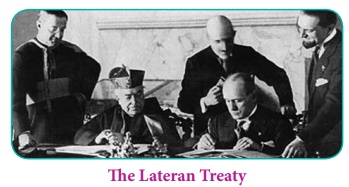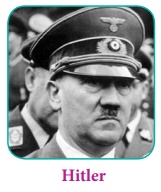Imperialism and its Onslaught | History - Rise of Fascism and Nazism | 12th History : Chapter 13 : Imperialism and its Onslaught
Chapter: 12th History : Chapter 13 : Imperialism and its Onslaught
Rise of Fascism and Nazism
Rise of Fascism and Nazism
In the aftermath of the First World War, the issue
in most parts of continental Europe was whether the government and the economic
system should continue under the control of feudal aristocracies,
industrialists and financiers, or a combination of all of them. But none of
these elite classes had won over the masses, especially the peasantry and the
labour. The masses in the emerging situation saw an opportunity to overthrow
their oppressors. In Russia the bourgeoisie overturned the autocracy in 1917
and were themselves overturned by the Bolsheviks. In Britain the Labour Party
handled the situation by opting for a welfare state. The vanquished nations
like Italy and Germany switched to fascism though movements which initially had
many of the characteristics of mass organisations.
(a) Fascism in Italy
The first of the nations of Western Europe to turn
against the old ruling regime was Italy. During World War I Italy mobilised
more than five and a half million men, of whom nearly 700,000 were killed. The
financial cost of the participation in the War was huge. The country had
suffered heavy losses in a war that was unpopular with both socialists and
pro-Austrian Catholics. The nationalists were equally unhappy with the marginal
gain in territory from the Treaty of Versailles. The War resulted in inflation
with consequent rise in prices, speculation and profiteering. There were
frequent protests and strikes. People held the rulers of Italy responsible for
the humiliation at Versailles.
Rise of Socialist Organisations
As hardship increased, socialist ideas began to
spread. In 1918 Italian socialists voted to join the Communist International.
In the election of November 1919 they won about a third of the seats in the
Chamber of Deputies. Radicalism spread even in rural areas. Red Leagues were
organised to break up large estates and to force landlords to reduce their
rents. To the landowning class fascism was a less dangerous form of radicalism
that could save their property from confiscation.
The Rise of Mussolini
Benito Mussolini (1883–1945), was a son of a
blacksmith. He qualified as an elementary school master and left for further
study in Switzerland but ended up as a journalist with socialist views. He
became the editor of Avanti, the
leading socialist daily. When the Fascist Party was founded in 1919 Mussolini
joined it immediately. As Fascists stood for authority, strength and
discipline, support came from industrialists, nationalists, ex-soldiers, the
middle classes and discontented youth. Fascists resorted to violence freely and
their opponents were attacked with knives, cudgels and guns.

The Fascist dictatorship arose out of the breakdown
of the parliamentary government which had proved unable to cope with the
disorders following the end of the War. The inability of the Democratic Party
leaders to combine and act decisively facilitated Mussolini’s triumph. What
threatened to become a civil war between the communists and their opponents was
ended by the march of the black-shirted Fascists on Rome (October 1922).
Impressed by the show of force, the King Immanuel III invited Mussolini to form
a government.
Fascism: The word Fascism derives its origin from the Latin fasces, the ax surrounded by a bundle of
rods representing the authority of the Roman state.
‘Fascism is a form of radical
authoritarian ultra-nationalism, characterised by dictatorial power, forcible
suppression of opposition and strong regimentation of society and of the
economy, which came to prominence in early 20th-century Europe’.
Fascists under Mussolini
In the 1924 elections, after intimidation of the
electors, the Fascists won 65 per cent of the votes. Matteotti, a socialist
leader, who questioned the fairness of the elections was murdered. The
opposition parties boycotted the Parliament in protest. Mussolini reacted by
banning opposition parties and censoring the press. Opposition leaders were
killed or imprisoned.
Assuming the title of Il Duce (the leader), in 1926
Mussolini became a dictator with power to legislate. He passed a law forbidding
strikes and lockouts. Unions and employers were organised into corporations
which would settle wages and working conditions. The greater part of the rest
of the population was grouped into corporations, according to occupation. These
were then organised into national federations and supervised by the Minister of
Corporations.
In 1938 Parliament was abolished and was replaced
by a body representing the Fascist Party and the corporations. This new
arrangement bolstered Mussolini’s dictatorial control of the economy, as well
as enabling him to wield untrammelled power as head of the administration and
the armed forces. Thus Mussolini destroyed parliamentary government, trade
unions and all democratic institutions.
Mussolini’s Pact with Pope
In order to give respectability to the Fascist
Party, Mussolini won over the Roman Catholic Church by recognising the Vatican
City as an independent state. In return the Church recognised the Kingdom of
Italy. The Roman Catholic faith was made the religion of Italy and compulsory
religious teaching in school was ordered. The Lateran Treaty incorporating the
above provisions was signed in 1929.

Great Depression Years
In 1929 the United States plunged into a great
financial and commercial slump. The effect on the rest of the world was grave.
By 1931 European trade and finance was totally paralysed. Though the Fascist
government in Italy could boast of achievements during this period in the much
publicised public works – new bridges, roads and canals, hospitals and schools
– it could not solve the unemployment problem. By 1935, when the collapse of
the League of Nations had become complete, Mussolini in order to have an
economic empire for Italy invaded Ethiopia. This was useful to divert attention
away from the economic troubles. Mussolini’s success drew admiration from
ruling classes elsewhere in Europe. Among them was a rising figure among
nationalist, anti-Semitic circles in Munich: Adolf Hitler.
(b) Germany in the post-War
The factors which led to the eventual triumph of
Fascism in Germany were many. First was the sense of humiliation arising from
the defeat in War. Between 1871 and 1914 Germany had risen to dizzy heights of
economic, political and cultural accomplishments. Germany’s universities, its
science, philosophy and music were known all over the world. Germany had
surpassed even Britain and the US in several fields of industrial production.
Then came the crushing defeat in the First World War. The German people were
demoralised. The reparations and other clauses in the Treaty of Versailles
caused acute discontent and hardship. This was utilised by reactionary forces
to spread the idea that Socialists and Jews in the government had let down the
nation, and had even caused the Germany’s defeat.
Germany had always been a military state. The army
was the symbol not merely of security but of national greatness. Therefore
Germany’s defeat and humiliation at the end of World War I caused a deep shock
to Germans. The Great Depression further deepened their frustration and
prompted them to turn against the Republican government.
Germany in the 1920s
Germany after the First World War formed democratic
governments through coalition of political parties. Socialist Ebert led the
government from 1919-1925 and later. Stresemann as one associated with liberal
democrats conducted the governance of the country until 1929. This period,
until the rise of the Nazis in 1933, is called the Weimar Republic.
The ordinary German citizen in these years was
concerned himself only with the problems of everyday life in an impoverished
country under the burden of reparations. The occupation of the Ruhr by the
French in 1923 infuriated the workers to organise strikes in protest. It
provided an opportunity to certain underground movements to thrive. There was
already one in Berlin under Ludendorff, who had organised the former soldiers
against the Republican government. There was another in Munich, a former
corporal. He was Adolf Hitler, the leader of the National Socialist German
Workers’ Party.

Evolution of German Fascism
During World War I, Hitler served in
the Bavarian
army. Hitler had developed an innate hatred against Jews and Marxists. A gifted
speaker, he could whip up the passion of the audience. In 1923 Hitler
abortively attempted to capture power in Bavaria. His premature launch of the
National Revolution on the outskirts of Munich landed him in prison. During his
time in prison he worked on Mein Kampf (My
Struggle), an autobiographical book
containing his political ideas.
In 1929 two things occurred which exposed the
weakness of the German government. Stresemann died and there was a political
vacuum. The failure of the New York Stock Market triggering economic depression
prompted the US to foreclose its German loans. By 1931 the world economic
depression had gripped an already feeble Germany. In the Presidential election
of 1932 the Communist Party polled about 60,00,000 votes. Alarmed capitalists
and property owners tilted towards supporting fascism. Hitler exploited this
opportunity to usurp powers.
The Third Reich
Republican government in Germany fell, as the
Communists refused to collaborate with the Social Democrats. Thereupon
industrialists, bankers and Junkers prevailed upon President Von Hindenburg to
designate Hitler as Chancellor in 1933 in the hope that they could control him.
The Nazi state of Hitler, known as the Third Reich, brought an end to the
parliamentary democracy established in Germany after the First World War.
Hitler replaced the flag of the Weimar republic by
the swastika banners of National Socialism. Germany was converted into a highly
centralised state. All political parties except the Nazi party were declared
illegal. The army of brown-shirted and jack-booted storm-troopers was expanded.
The Hitler Youth was created, and the Labour Front set up. Trade unions were
abolished, their leaders were arrested and all workers were compelled to join
the German Labour Front. Strikes were made illegal, wages were fixed by the government,
and the Labour Front was used by the Nazis to control industry. Total state
control was extended over the press, the theatre, the cinema, radio and over
education.
The Nazi Party’s propaganda was led by Joseph
Goebbels, who manipulated public opinion through planned propaganda. He once
said, ‘any lie frequently repeated will ultimately gain belief.’ The Gestapo or
Secret State Police was formed and run by Himmler, who controlled the select
bodyguard of Hitler.
Nazi Policy towards Jews
Along with the repressive measures, Hitler’s
government followed a policy of repressing Jewish people. The Jews were removed
from government positions, excluded from the universities and deprived of
citizenship. Jewish businesses were closed down, and their establishments were
attacked. After the outbreak of World War II concentration camps, barracks
surrounded by electrified fences and watch towers, were built where Jews were
interred and used as forced labour with less than subsistence nourishment.
Later they were turned into extermination camps where industrial means of
murder such as gas chambers were used to kill Jews. It is estimated that about
6 million Jews in Europe were killed in what the Nazis termed ‘The Final
Solution’. Apart from Jews, the Nazi state also exterminated gypsies, and other
itinerant communities, homosexuals and lunatics. Apart from these, several
hundreds of thousands of Germans who dissented with Hitler too were killed.
Defiance of the Treaty of Versailles
In August 1934 Hindenburg died and
Hitler, apart from being Chancellor, became both President and
Commander-in-Chief of the armed forces. By 1938 the Nazi Party had
tightened its control over the army. Hitler’s foreign policy aimed at restoring
the armed strength of Germany and annulling provisions of Versailles Treaty
which undermined Germany. His deliberate attempts to breach the Treaty of
Versailles (discussed in the next lesson) led to the outbreak of Second World
War.
Related Topics